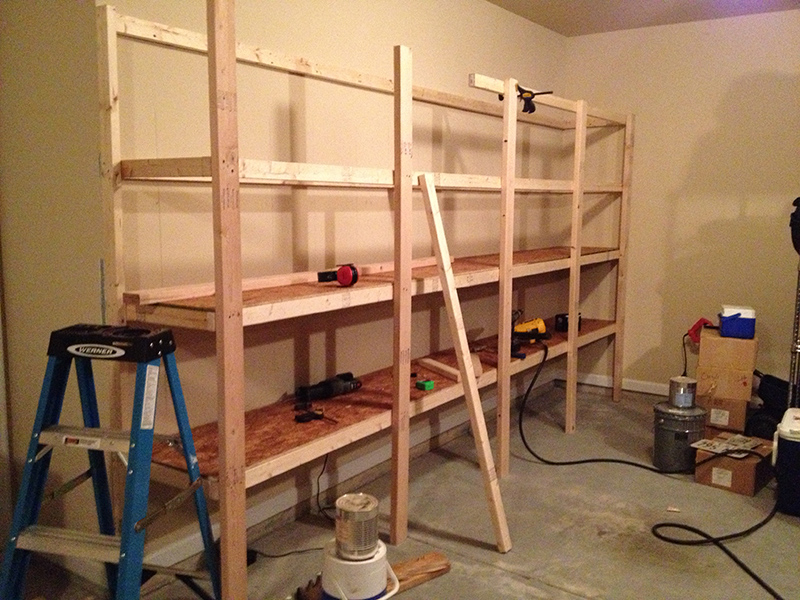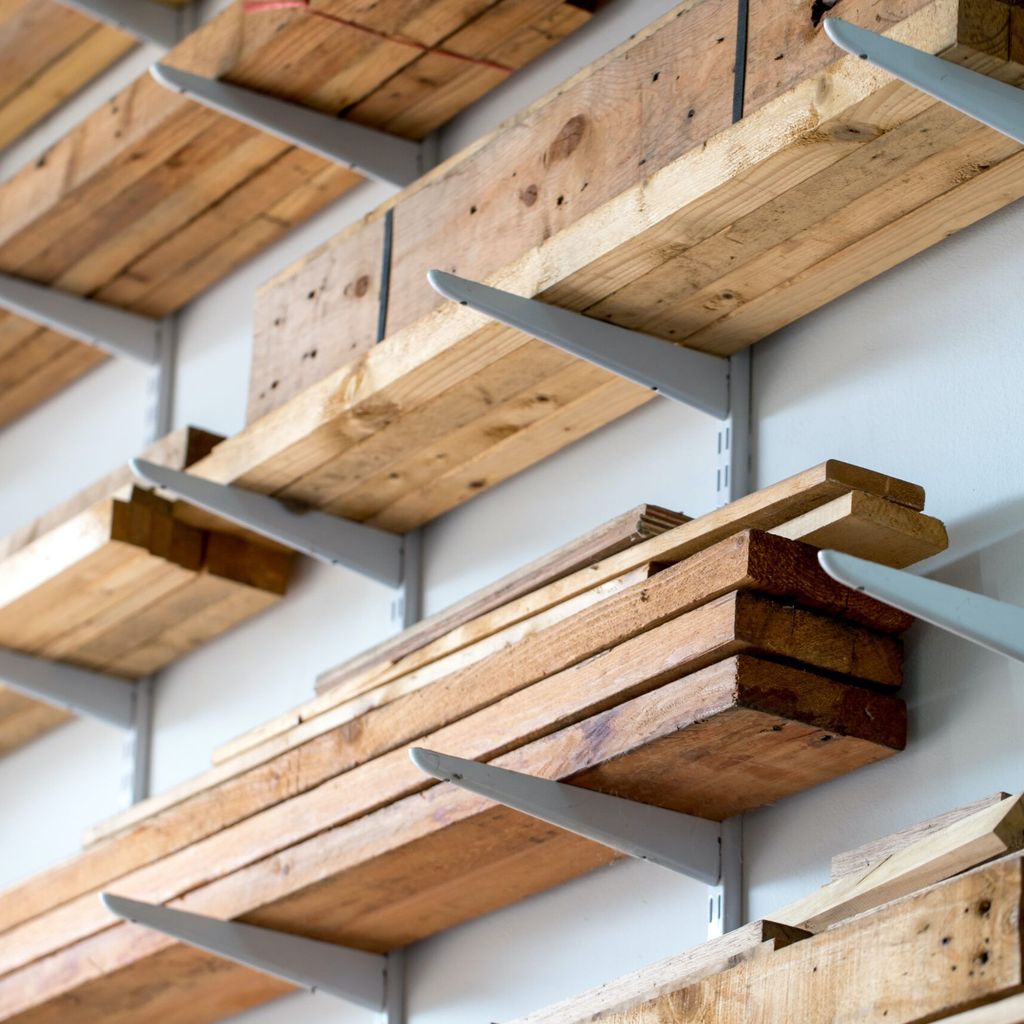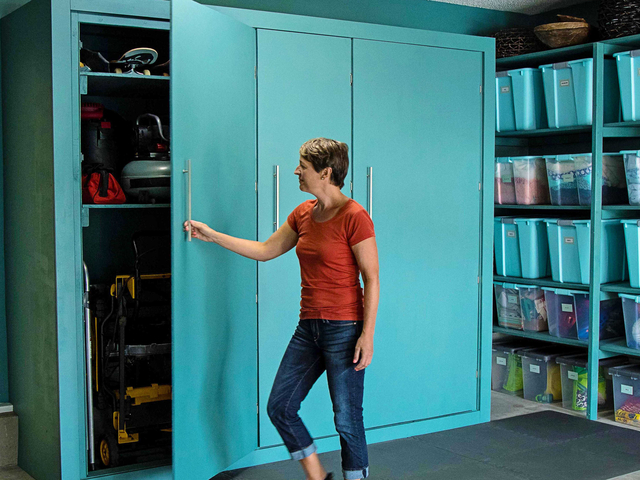Introduction
How To Build Wall Mounted Garage Shelves: We will walk you through the process of constructing sturdy and functional wall-mounted garage shelves. Whether you’re a seasoned DIY enthusiast or a beginner, you’ll find these instructions easy to follow.
We’ll start by discussing the materials and tools you’ll need for the project. From basic hardware to the necessary lumber, we’ll provide a detailed list to ensure you have everything ready before you begin. Next, we’ll guide you through the planning phase, helping you determine the ideal shelf dimensions and layout to suit your specific needs.
Once the planning is complete, we’ll move on to the construction process. You’ll learn how to measure and mark the wall for accurate installation, secure the brackets or supports, and attach the shelves securely to the wall. We’ll also cover important considerations such as weight capacity and reinforcing the shelves for heavier items.
Throughout the tutorial, we’ll provide useful tips and suggestions to make your shelf-building experience smooth and successful. By the end of this guide, you’ll have practical, space-saving garage shelves that will transform your storage area.

How deep are garage shelves?
12 – 24 inches deep
How deep should garage shelves be? – The depth of your shelves may depend on what you plan to store and how much space you have in your garage. Garage shelves typically range from 12 – 24 inches deep.
The depth of garage shelves can vary depending on the specific needs and available space. Generally, the depth of garage shelves ranges from 12 to 24 inches (30 to 61 centimeters).
A depth of 12 to 16 inches (30 to 41 centimeters) is commonly used for storing smaller items, such as tools, gardening supplies, and paint cans. These shelves provide sufficient space to keep these items organized and easily accessible.
Such as bulky storage containers, power tools, or larger equipment, a depth of 18 to 24 inches (46 to 61 centimeters) is often recommended. This allows for adequate space to accommodate the size and dimensions of these items.
It’s important to consider the available space in your garage when determining the depth of your shelves. Take into account factors like the clearance needed for vehicles, doors, or other obstructions. Additionally, consider the layout and arrangement of your garage to optimize space utilization.
Flexibility is key when designing garage shelves. Adjustable brackets or supports can provide versatility in depth, allowing you to modify the shelf depth as your storage needs change over time.
The depth of your garage shelves should be determined by the types and sizes of items you intend to store, while considering the available space and overall functionality of your garage.
What to use for garage shelves?
There’s no need to use fancy materials for garage shelves, not when the main goal is to make sure they’re durable and practical. OSB boards and even plywood can work and reclaimed wood is always a good option as well.
There are several options for materials that you can use to build garage shelves, depending on your preferences, budget, and the intended use of the shelves. Here are a few commonly used materials:
Plywood: Plywood is a popular choice for garage shelves due to its affordability and versatility. It is available in various thicknesses and can be cut to custom sizes. Plywood shelves can be supported by brackets or built with a frame for added stability.
Solid Wood: Solid wood shelves provide a sturdy and durable option for garage storage. Common choices include pine, oak, or maple. Solid wood shelves can be built with adjustable brackets or as freestanding units. They offer a more aesthetic appeal and can be stained or painted to match your garage decor.
Wire Shelving: Wire shelving is a lightweight and easy-to-install option. It is often made of metal, providing excellent ventilation and visibility of stored items. Wire shelves are adjustable, allowing you to customize the height between shelves as needed. They are a popular choice for storing items like bins, boxes, and sports equipment.
Metal Shelving: Metal shelving units are sturdy and capable of supporting heavier loads. They are typically made of steel and come in various sizes and configurations. Metal shelves are resistant to moisture and can withstand harsh garage environments.
When selecting the material for your garage shelves, consider factors such as weight capacity, durability, aesthetics, and budget. Each material has its own advantages, so choose the one that best suits your needs and preferences for a functional and efficient garage storage solution.
What is the best height for garage shelves?
You can go floor to ceiling, but after 6 feet tall, it is very hard to access the shelving. So only place very rarely used items, or lightweight items like sleeping bags, on high shelves. How much space do you need between storage shelves? For household items, 12″ is a good height.
The best height for garage shelves depends on various factors such as the available space, the types of items you plan to store, and your personal preferences. However, there are some general guidelines to consider when determining the height of your garage shelves.
Accessibility: The primary consideration is to ensure that you can easily reach and retrieve items from the shelves. Shelves that are too high may require the use of step stools or ladders, which can be inconvenient and potentially unsafe. Generally, it is recommended to keep the shelves at a height that allows you to comfortably reach items without excessive stretching or bending.
Clearance: Take into account any potential obstructions or fixtures in your garage, such as doors, windows, electrical outlets, or light fixtures. Leave sufficient clearance between the shelves and these elements to ensure unimpeded functionality and safety.
Ceiling height: If your garage has a low ceiling, it may limit the maximum height of your shelves. Leave enough space between the top of the shelves and the ceiling to avoid any collisions or restrictions.
Item size and weight: Consider the size and weight of the items you plan to store on the shelves. If you have larger or bulkier items, ensure that the shelves are tall enough to accommodate them without causing overcrowding or instability.
A height range of 12 to 18 inches (30 to 46 centimeters) between shelves is commonly used. This allows for efficient storage of various items while maintaining accessibility. However, feel free to adjust the height based on your specific needs and preferences.
The best height for your garage shelves should strike a balance between accessibility, clearance, and the types of items you plan to store, ensuring a functional and well-organized space.

How much weight can garage shelves hold?
Garage shelves typically come as wall-mounted, ceiling-mounted, or freestanding units, and they can hold anywhere from a few hundred pounds to a few thousand pounds depending on the unit’s size and material.
The weight capacity of garage shelves can vary depending on the materials used, the design of the shelves, and the supporting brackets or supports. It is important to consider weight capacity to ensure the structural integrity and safety of the shelves.
Garage shelves can hold a range of weight loads. Light-duty shelves designed for storing smaller items, such as tools, paint cans, or gardening supplies, can typically support around 50 to 200 pounds (23 to 91 kilograms) per shelf.
Medium-duty shelves, suitable for storing heavier items like power tools or storage boxes, can typically hold between 200 to 800 pounds (91 to 363 kilograms) per shelf.
Heavy-duty shelves, often used for storing bulky items or equipment, can have weight capacities ranging from 800 to over 2,000 pounds (363 to 907 kilograms) per shelf.
It is essential to refer to the manufacturer’s specifications for the specific weight capacity of the materials and components you are using. These guidelines will provide accurate information on the weight limits and ensure that the shelves are not overloaded, which could lead to instability or collapse.
Distributing weight evenly across the shelves and properly anchoring the brackets or supports to the wall studs will help maintain the shelves’ stability and weight capacity.
Always err on the side of caution and avoid exceeding the recommended weight limits to ensure the safety and longevity of your garage shelves.
How do I ensure that the shelves are securely attached to the wall?
To ensure that your wall-mounted shelves are securely attached, follow these steps for a stable and reliable installation.
Locate studs: Start by locating the studs in your wall. Use a stud finder or tapping method to identify the solid vertical beams behind the drywall. These studs provide the necessary strength to support the weight of the shelves and the items you plan to store on them.
Mark stud positions: Once you’ve located the studs, mark their positions on the wall using a pencil or masking tape. This step is crucial as it ensures that the brackets or supports for the shelves are anchored to the studs rather than just the drywall.
Drill pilot holes: Use a drill with an appropriate size drill bit to create pilot holes at the marked stud positions. The pilot holes will make it easier to insert the screws or bolts and prevent the wood from splitting.
Attach brackets/supports: Align the brackets or supports with the pilot holes and secure them to the wall using screws or bolts. Make sure they are level and firmly attached to the studs. If using adjustable brackets, adjust them to the desired shelf height.
Install shelves: Once the brackets or supports are securely attached, it’s time to install the shelves. Place the shelves onto the brackets, ensuring they fit snugly and are level. Double-check the stability and adjust the brackets if needed.
Test for stability: After installing the shelves, give them a gentle shake to test their stability. They should feel sturdy and not wobble or sway. If any movement is detected, recheck the brackets’ attachment or consider adding additional support.
You can ensure that your wall-mounted shelves are securely attached to the wall, providing a safe and reliable storage solution for your garage.
Are there any weight capacity considerations when building wall-mounted garage shelves?
Weight capacity considerations are crucial when building wall-mounted garage shelves to ensure their structural integrity and prevent any accidents or damage. Here are some important points to keep in mind:
Know the weight limits: Before starting your project, be aware of the weight limits specified by the materials you’re using, such as the brackets, supports, and shelves themselves. Manufacturers usually provide weight capacity information for their products, so consult the product specifications or packaging for this crucial detail.
Consider the load distribution: Distribute the weight evenly across the shelves to maintain balance and stability. Avoid placing excessively heavy items on one side, as it can strain the brackets or supports and potentially cause the shelves to sag or collapse.
Reinforce for heavy items: If you plan to store particularly heavy items on your shelves, consider reinforcing them to handle the additional weight. This can involve using thicker or sturdier lumber for the shelves, adding extra brackets or supports, or incorporating cross-bracing for added support.
Reinforce attachment points: Ensure that the brackets or supports are securely attached to the wall studs. If necessary, use longer screws or bolts for a stronger connection. Reinforcing the attachment points helps distribute the weight more effectively and reduces the risk of failure.
Regularly inspect for signs of stress: Even after installation, periodically inspect your wall-mounted shelves for any signs of stress or strain, such as sagging or bending. If you notice any issues, consider redistributing the weight or adding additional support to prevent potential accidents.
By considering weight capacity limitations, evenly distributing the load, reinforcing as needed, and regularly inspecting your shelves, you can ensure they can safely support the intended weight and maintain their stability over time.
Can I reinforce the shelves for heavier items, and if so, how?
Yes, you can reinforce the shelves to support heavier items effectively. Here are some methods to reinforce your wall-mounted shelves:
Choose sturdier materials: Opt for thicker and stronger lumber for the shelves themselves. Consider using plywood or solid wood boards with a higher weight-bearing capacity. Reinforcing the material itself provides a more solid foundation for heavier items.
Add additional brackets or supports: Increase the number of brackets or supports underneath the shelves to distribute the weight more evenly. Space them closer together, especially in the areas where you plan to place heavier items. This will help prevent sagging and ensure better weight distribution.
Incorporate cross-bracing: Install additional cross-braces on the underside of the shelves for added stability and reinforcement. Cross-braces are diagonal supports that connect the vertical brackets or supports, providing extra strength and preventing the shelves from swaying or bending.
Reinforce attachment points: Ensure that the brackets or supports are securely attached to the wall studs. Consider using longer screws or bolts for a stronger connection. This reinforces the attachment points and prevents the shelves from pulling away from the wall under the weight of heavier items.
Consider metal brackets or supports: Instead of using traditional wooden brackets, you can opt for metal brackets or supports specifically designed for heavy-duty applications. Metal brackets often provide higher weight capacities and increased durability.
By implementing these reinforcement techniques, you can enhance the weight-bearing capacity of your wall-mounted shelves, providing a solid and secure storage solution for heavier items in your garage. Remember to consider the weight limits of your materials and regularly inspect your shelves for signs of stress or strain to ensure their continued stability.
Any tips for organizing and maintaining wall-mounted garage shelves effectively?
Here are some valuable tips for organizing and maintaining your wall-mounted garage shelves effectively:
Categorize items: Group similar items together and assign designated shelves or sections for different categories. This makes it easier to locate items and maintains a systematic organization system.
Use storage containers: Invest in storage containers, bins, or boxes to keep smaller items organized. Label them clearly to identify contents quickly. Stackable containers can maximize vertical space utilization.
Utilize hooks and hanging storage: Incorporate hooks, pegboards, or hanging organizers on the walls near the shelves to hang tools, cords, or other items with handles. This helps free up shelf space and keeps frequently used items within easy reach.
Prioritize accessibility: Store frequently used items within arm’s reach and less frequently used ones on higher or lower shelves. This ensures convenience and prevents unnecessary reaching or bending.
Regularly declutter and clean: Set aside time periodically to declutter your shelves, removing items you no longer need or use. Clean the shelves and wipe down the surfaces to maintain a neat and dust-free environment.
Adjust as needed: Be open to adjusting the organization of your shelves as your storage needs change over time. Stay flexible and make adjustments to accommodate new items or rearrange categories for better efficiency.
Regular maintenance checks: Routinely inspect the shelves for any signs of damage, sagging, or instability. Address any issues promptly to prevent accidents and ensure the longevity of your shelves.
You can create an organized and functional system for your wall-mounted garage shelves, maximizing their efficiency and making your garage a more streamlined and accessible space.

Conclusion
With your new shelves in place, you’ll enjoy the benefits of having easy access to your tools, equipment, and supplies. No more searching through piles of clutter or struggling to find what you need. Everything will have its designated spot, ensuring a streamlined and functional garage.
Remember to regularly maintain and organize your shelves to maximize their effectiveness. Keep items neatly arranged, label storage bins for quick identification, and make adjustments as your storage needs evolve over time.
Now that you’ve mastered the art of building wall-mounted garage shelves, consider sharing your newfound knowledge with others. Help friends, family, or even your community create their own storage solutions. We hope this guide has empowered you to tackle more projects and enhance your living spaces. Enjoy your newly organized garage and continue exploring the world of do-it-yourself endeavors.


